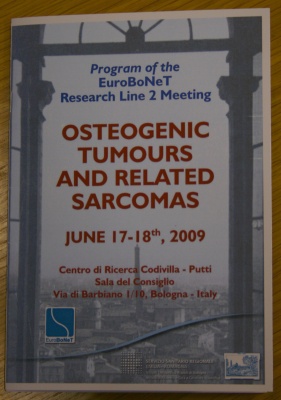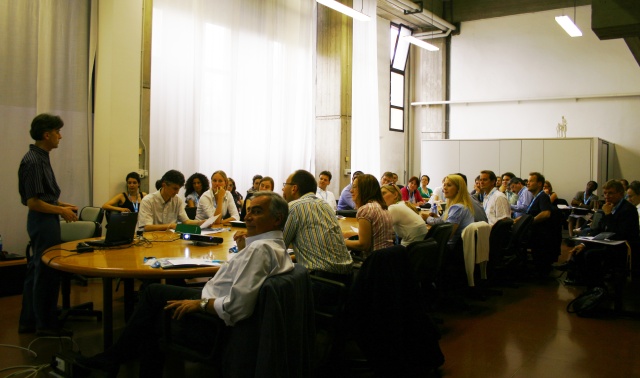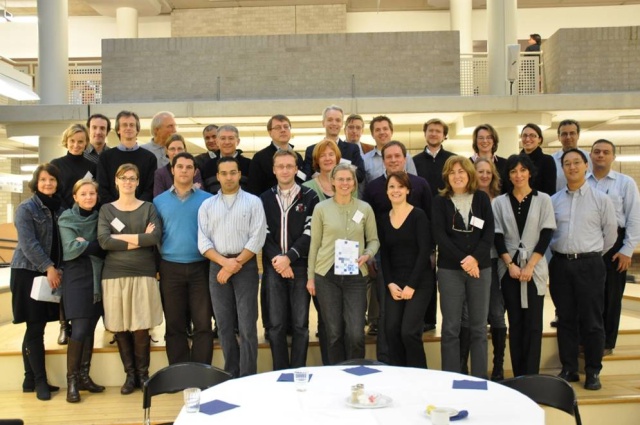Newsletter 04/09 |
EuroBoNet moves research discoveries to the clinic
The research line programmes have now identified new targets for treatment, and the EuroBoNet translational workpackage has now been consolidated with a small translational team working with the EuroBoNet centres.
Professor Bass Hassan, a medical oncologist and laboratory group leader, University of Oxford, has been recruited to co-ordinate a clinical fellow, trials research manager with the major clinical units linked with the EuroBoNet centres. The team will develolp four focused on four trials in bone sarcoma, with the aim of presenting these ideas at the forthcoming EuroBoNet annual meeting in January 2010 in Münster, Germany. Bass Hassan aims to closely integrate these early phase studies with the international trial groups and the pharmaceutical companies.
The aim is to provide new treatment opportunities for patients with osteosarcoma, chondrosarcoma, Ewings sarcoma and giant cell tumours of bone. Bass Hassan's commented at the recent research RLq and RL3 line meetings.
"The work of EuroBoNet has shown how work through networks of excellence and collaboration can deliver new information that now be tested in patients, and the direct link of the exciting scientific developments are now realistic". In his summary of the research line meetings over the last three months, Professor Pancras Hoogendorn summarised the outcomes. "We are on track, and have important targets to be explored and developed. Its very exciting that we will be able to see how effective EuroBoNet research will be in the clinic. However, we have much work to do to maintain the momentum and to support the translational teams we have in place".
|

Photo: Bologna |
|
|
|
|
Report On RL2 Meeting
Opening of the Meeting: H. Bürger (Münster, Germany)
It is not possible to cooperate with Euramos concerning recruitment of the American samples. However, it might be possible to receive Euramos samples to build a tissue array after the end of the Euramos protocol.
WP2.1: O. Myklebost (Oslo, Norway)
Several integrated activities inside and outside the RL2 line on genomic profiling, microRNA profiling, SNP arrays and in vivo studies.
Integration between genomic data from different platforms are ongoing.
Manuscripts involving different EuroBoNeT Partners are in preparation or submitted.
WP 2.2: M. Serra (Bologna, Italy)
Several integrated activities inside the RL2 on gene copy number, gene expression and methylation profiling, drug sensitivity analyses and characterization of bone tumors.
This Research Unit will evaluate the sensitivity to the most common chemotherapeutic drugs (IC50 assessed either with the MTT assay or Trypan blue dye exclusion) on the whole EuroBoNeT osteosarcoma cell line panel and will provide this information to the whole Network.
It is planned to use the SOLVO kits to analyze the ABC activity in OS cell lines.
Manuscripts involving different EuroBoNeT Partners are in preparation or submitted.
WP2.3: F. Mertens (Lund, Sweden)
Several integrated activities inside the RL2 on the characterization of chordomas, vascular tumors, fibrosarcoma (FS) and malignant fibrous histiocytoma (MFH) of bone.
Papers involving different EuroBoNeT Partners are coming out.
During the discussion, K. Szuhai (Leiden) reported technological problems in using paraffin-embedded archived tumor samples for genetic analyses.
H. Bürger (Münster, Germany)
Histological revision of MFH of bone, FS of bone will be soon performed in Treviso (Pr. P. Dei Tos research group together with the EuroBoNeT pathologists panel). Paraffin-blocks for histological revision have been already sent to Treviso or will be transferred there from Münster.
P. Hogendoorn (Leiden, The Netherlands)
The project Coordinator reported financial and strategic information, together with some suggestion for KP7.
Euramos samples should be included into the EuroBoNeT database, despite the situation explained by Pr. Bürger at the beginning of the meeting.
L. Meza-Zepeda (Oslo, Norway)
Integration of genome wide data concerning gene copy number, expression, methylation and microRNA profiling are ongoing.
Comparison between gene profiling of osteosarcoma versus normal cells are also planned.
H.M. NamlØs (Oslo, Norway)
microRNA analysis of EuroBoNeT osteosarcoma cell lines versus normal bone and between some osteosarcoma subgroups have been performed.
Correlations between microRNA and mRNA levels are ongoing in order to identify the target genes of altered microRNAs.
E. Buddinghs' (Leiden, The Netherlands)
Natural killer (NK) cells activity in osteosarcoma cell lines (drug sensitive and drug resistant) has been analyzed.
All osteosarcoma cells are sensitive to NK, however drug resistant cells are less sensitive to NK lysis compared to the parental, drug sensitive cell lines.
A. Mohseny (Leiden, The Netherlands)
Leiden has established an experimental model based on mouse mesenchimal stem cells which form osteogenic tumors.
However, it is problematic identifying the genetic aberrations which are relevant for the malignant transformation of these cells.
The next aim is to perform similar analyses in normal human mesenchimal stem cells.
E. Korshing (Münster, Germany)
Integration of genomic profiling data from different platforms is ongoing and will be performed by using the NEXUS system replacing the Curie approach.
The presented PennCNV approach will be used additionally to other established algorithms for the SNP analysis.
The plan is to perform the analyses of gene expression and SNP data on NEXUS and, in a second line, by PennCNV + R/S.
The next bioinformatic meeting is planned for October 2009.
M. Kuijjer (Leiden, The Netherlands)
Report on expression profiling data obtained from 94 biopsies of high-grade osteosarcoma, for which complete clinicopathologic and follow-up data are available.
Profiling has been done on the ILLUMINA Human-6 v2 chips platform (48701 different probe sequences) and data were processed with the R software.
Good and poor responders (cut-off value for percentage of necrosis=90) do not show differential expression.
Genes specific for each osteosarcoma histological subtype have been identified.
Immune system genes were down-regulated in patients who developed metastasis.
Pathways analysis and integration with genomic data are ongoing.
Y. Cai - A. Mohseny (Leiden, The Netherlands) and I. Machado (Valencia, E)
Report on some pathways analysis in the EuroBoNeT osteosarcoma cell lines panel.
Almost 50% of cell lines gave tumors after s.c. injection in nude mice: for each cell line which grew in mice images of histology and immunohistochemistry are available.
Osteogenic and adipogenic capabilities have been studied in vitro for all the EuroBoNeT osteosarcoma cell lines panel.
BMP, IHh, and Wnt pathways are presently under analysis in the EuroBoNeT osteosarcoma cell lines panel (both in vitro and in vivo). The Wnt pathway has been analyzed more in detail in these cell lines (stimulation of Wnt pathway stimulates osteoblastic differentiation and inhibits cell proliferation): in vivo analysis is ongoing in mouse models with the GIN drug (an inhibitor of GSK3b).
L. Schäfer (Düsseldorf, Germany)
Focus on the characterization of the EuroBoNeT osteosarcoma cell lines panel and, in particular, on TP53 and CDNK2 status in osteosarcoma in comparison with Ewing cell lines.
TP53: among the osteosarcoma cell lines, 4 showed missense mutations; 5 non-sense mutations; and 11 were wt-P53.
Telomerase activity of the whole panel have been completed and data are available.
SKY analysis of 15 cell lines has been also completed.
Tissue arrays of the whole EuroBoNeT osteosarcoma cell lines panel is available and currently used.
I. Machado (Valencia, Spain)
Characterization of a case of small cell osteosarcoma resembling a Ewing sarcoma phenotype.
Analysis of several different osteogenic and non-osteogenic markers may help to distinguish between these two tumor entities.
S. Romeo (Treviso, Italy)
Histologic classification of fibrosarcoma (FS) and malignant fibrous histiocytoma (MFH) of bone: in the WHO 2002 these two entities were kept as distinct histologic subtypes and were specified the bases for the differential diagnosis between these sarcomas and other similar tumor entities.
Histological revision of the EuroBoNeT FS and MFH of bone cases will be soon performed in Treviso: additional new cases must be sent to Treviso within the next 4 weeks.
A tissue microarray may be built from the paraffin blocks, which have been sent and collected in Treviso.
P. Hogendoorn (Leiden, The Netherlands)
The Project Coordinator summarizes the major benefits of the network:
- Collection of a huge number of samples
- Sharing of technology and resources
- Integration between different Institutes and Research Groups
On these bases, it would be wise to put forward a rationale for a possible "EuroBoNeT II".
A.B. Hassan (Oxford, UK)
Planning of translational research activities inside EuroBoNeT should mainly focus on the identification of diagnostic, prognostic markersand possibly therapeutic targets to be transferred into the clinical practice.
It is higly important to produce a list of the novel diagnostic and prognostic markers identified so far and to let it circulate inside the EuroBoNeT network.
Some examples may be already present: biphosphonates and Denosumab in giant cell tumor of bone; IGF-IR and CD99 in Ewing sarcoma; SRC (Dasatinib), CDK (flavopiridol) and PI3 kinase in condrosarcoma.
The network should identify, propose and validate candidate therapeutic targets and new drugs to be considered for possible innovative therapeutic approaches.
|

Photo: Bologna Meeting

Photo: Bologna Meeting
|
|
|
Report On RL4 Meeting, Helsinki, July 2009
On July 9-10, Research Line 4 held its annual meeting, hosted by Sakari Knuutila, in Helsinki.
All the Centers involved in this RL were present, represented by the following researchers:
Amaral Ana-Teresa Athanasou Nick, Berghuis Dagmar, de Alava Enrique, Dirksen Uta, Gajewski Melanie, Garcia Daniel, Garofalo Cecilia, Hogendoorn Pancras, Hotfilder Marc, Knowles Helen, Knuutila Sakari, Lankester Arjan, Llombart-Bosch Antonio, Lopez Guerrero Jose Antonio, Manara Cristina, Martins Ana-Sofia, Niini Tarja, Ottaviano Laura, Picci Piero, Savola Suvi, Schaefer Karl-Ludwig, Scheinin Ilari, Scotlandi Katia, Szuhai Karoly, Vakkila Jukka, Ventura Selena, and the guest speaker Monni Outi. The group from the Helsinki lab also participated at the meeting with Borze Ioana, Ene Ana Maria, Koivumaa Minna, Kowan Jee, Mosakhani Neda, Musse Suad, Myllykangas Samuel, Nieminen Tarja, Ninomiya Shinsuke.
The 3 WPs Leaders (E. De Alava, A. Lankester, K. Scotlandi) reported the results of the more recent studies and chaired 3 sessions on Biology, new therapies, prognostic markers and genetic studies. Outi Monni, from Helsinki presented the guest talk on Novel Molecular Profiling Technologies in Cancer Research.
|

Photo: Helsinki
|
|
|
Report on RL1 Meeting, University of Antwerp , Autumn, 2009
The 3rd research line 1 (RL1) meeting was held in the city of Antwerp
(Belgium) at September 30th and October 1st. 29 participants
attended, presented their data and discussed the results obtained in
the 4 work packages.
In WP1.1 research concentrates on chondrosarcoma biology. Expression
profiling of chondrosarcomas was presented with the focus on
identifying potential targets/pathways for therapy. These include BMP,
estrogen signaling and apoptosis pathways.
The WP1.2 presentations on benign cartilage tumors included analysis of
Ollier disease associated enchondromas aiming to identify the genetic
cause of this disorder. The analysis of an EXT2 zebra fish model (dak)
showed that inactivation of this gene not only results in a bone
phenotype, but also that dental abnormalities could be observed, both
in fish and possibly in human.
Mutations in EXT1 and EXT2 result in multiple osteochondromas, the
focus of WP1.3. The launch of a new online EXT1/EXT2 mutation
database (MOdb) and the characterization of the EXT1 promotor was
presented. Available experimental data on the double hit versus
haploinsufficiency theory for the development of MO was, interactively
with WP1.2, provided by two partners.
Evaluation of RL 1 deliverables and milestones further shows that the
various work packages are performing well and that this research line
is well on track.
|
| |
|
|
Report on RL3 Meeting, University of Antwerp October 2-3, 2009
RL3 EuroBoNet members met at the University of Antwerp to present data and discuss progress in RL3. Some of the highlights of this meeting include identification of new proteins of high prognostic significance in giant cell tumour of bone (GCTB), further analysis of the role of hypoxia in osteoclast formation and resorption and analysis of growth factors involved in non-canonical human osteoclast formation. The role of centrosome abnormalities in GCTB was presented and there was an update on correlation of gene and protein expression in primary and secondary GCTBs and Paget's disease, where polymorphism studies have examined possible functional candidate genes that may play a role in the development of sporadic Paget's disease.
A large number of collaborative clinicopathological studies have been carried on in RL3 including a major European multicentre study on outcomes following bisphosphonate treatment of GCTBs. A number of studies of other giant-cell rich tumours have been completed or are in the process of being completed.
The RL3 group is performing well with regular staff exchange and frequent sharing of tissue and technical resources. There is clearly scope for development of the research undertaken in RL3 and further analysis of GCTB and related bone tumours is planned in the coming year. Collaborative research into GCTB is now an established area of pathology and oncology research into bone tumours in Europe.
|
| |
|
|

Photo: Participants and course leaders at Boerhaave course on 'Practical clinical, radiological and pathological diagnosis of skeletal tumours,'
6-18 November, 2009, Leiden
|
| |
|
|
| |
|
|